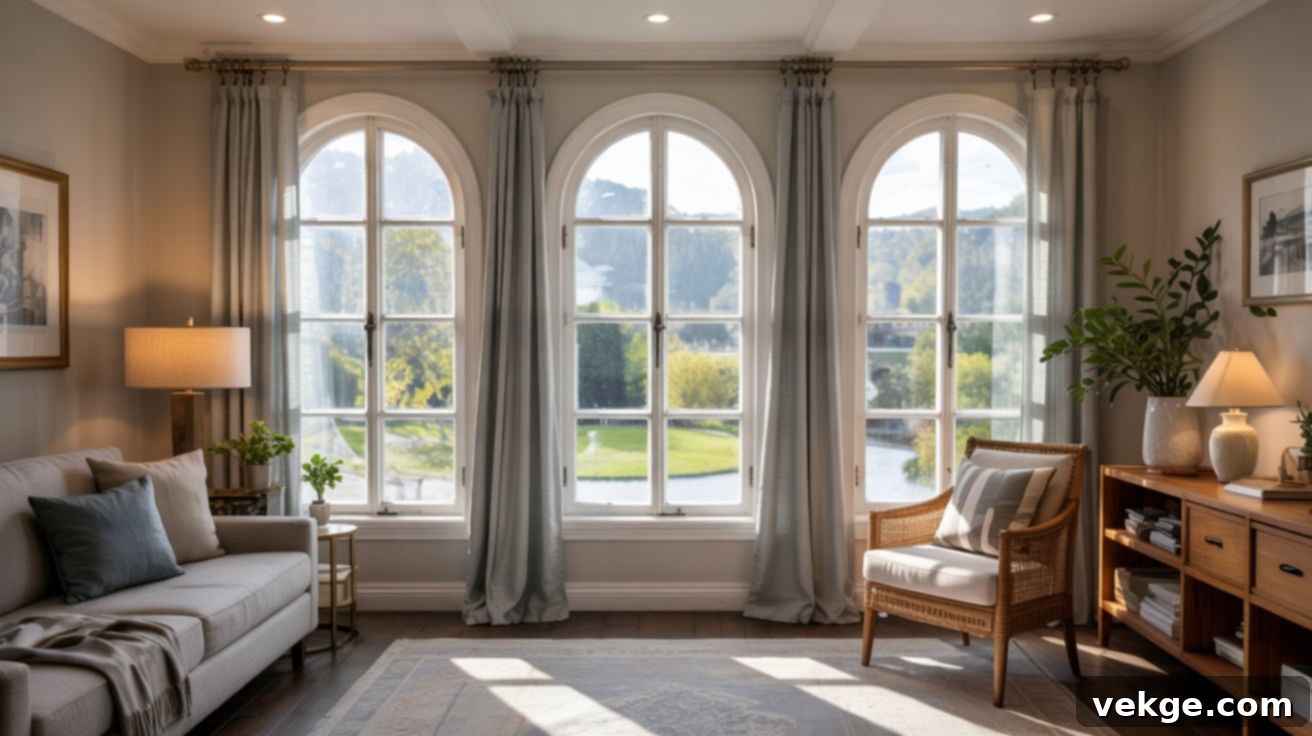Expert Guide to Hanging Curtains on Three Windows: Ideas, Installation, and Style Tips
Hanging curtains for a set of three windows might seem like a straightforward task, but it involves more than simply choosing attractive fabric. To achieve a truly polished and functional outcome, you need to carefully consider the window layout, select the appropriate rod setup, and ensure that everything fits perfectly and hangs evenly. The right window treatment can dramatically transform your space, whether you’re aiming for a simple, clean aesthetic or a more dramatic, layered look.
This comprehensive, step-by-step guide will walk you through the entire process. From precise measurements and selecting the ideal curtains to choosing the right hardware and executing a flawless installation, we’ll cover every detail. By the end, you’ll possess the confidence and knowledge needed to tackle your triple window treatments like a seasoned professional, enhancing both the style and comfort of your home.
Why Three Windows Demand Thoughtful Planning
When you’re dealing with three windows grouped side-by-side, the complexity of the task increases significantly. It’s not just about covering the glass; you need to consider the entire wall space, visual balance, and how the chosen window treatment will integrate with the overall room decor. Treating multiple windows as a single unit, or as distinct elements, requires a strategic approach to ensure a harmonious and appealing result.
Common Layout Challenges with Triple Windows
More extensive wall space naturally translates to a need for more fabric, longer curtain rods, and additional support brackets. Without adequate support, long rods are highly susceptible to sagging in the middle, especially when bearing the weight of heavier curtains. This can instantly detract from an otherwise beautiful setup, making it appear poorly executed and untidy.
Uneven hanging is another prevalent issue. Curtains that don’t align perfectly or fail to slide smoothly can disrupt the entire aesthetic, creating an unbalanced and unprofessional appearance. Furthermore, using panels that are too short can make the windows look awkward, unfinished, and smaller than they actually are. It’s crucial to create a balanced look that thoughtfully frames the full width and height of the window area. When executed correctly, the curtains should gracefully frame the space, enhancing its features without appearing overly bulky or too sparse.
Where You’ll Encounter Triple Window Layouts Most Often
Triple windows are a popular architectural feature, frequently appearing in key rooms where both aesthetic appeal and practical functionality are paramount. Understanding these common placements can help in planning the most effective curtain solutions:
Living Rooms with Expansive Walls
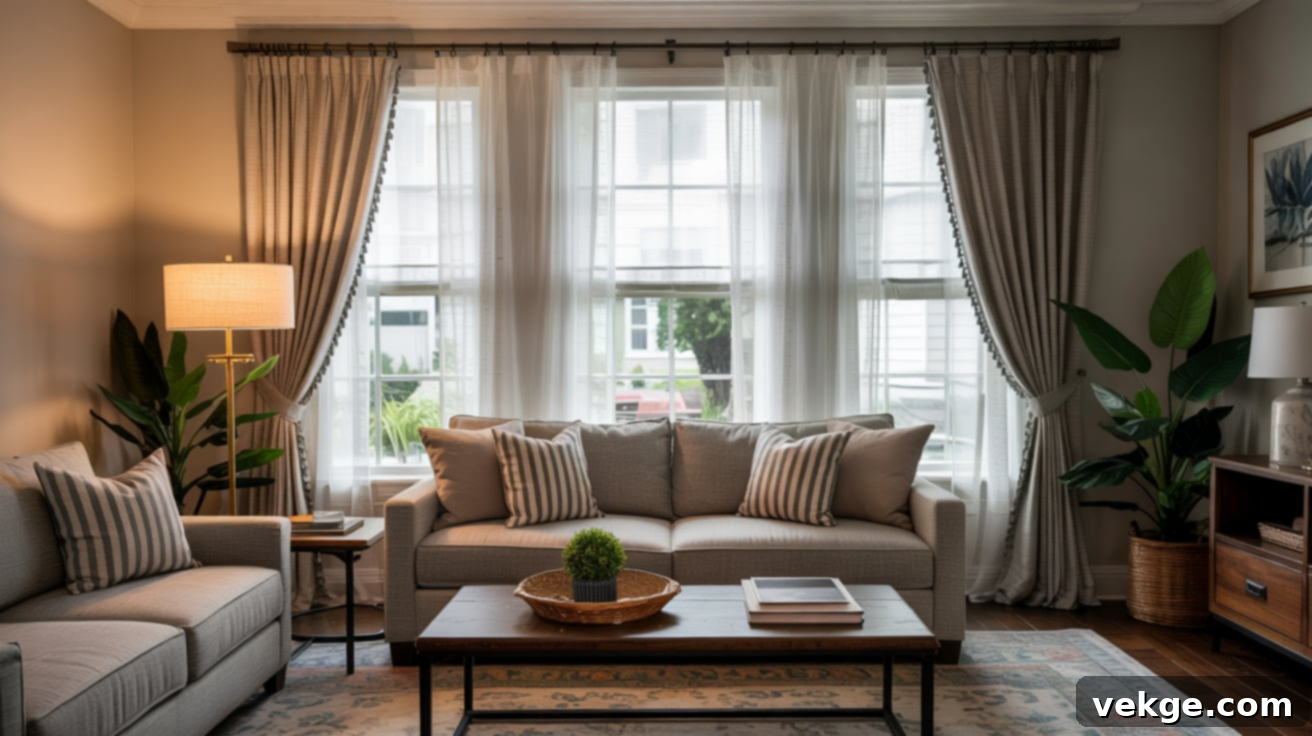
Living rooms often boast large walls featuring three windows, specifically designed to maximize natural light and create an open, inviting atmosphere. This arrangement typically forms a significant focal point in the room, necessitating a carefully considered curtain setup. A common and effective approach involves using one continuous, long rod that spans across all three windows, with wide curtain panels positioned at either end. Delicate, soft sheers can be hung in the center sections, maintaining a balanced, airy feel while still offering a degree of light control and privacy.
For a sophisticated and tidy appearance, aim for floor-length curtains. These not only draw the eye upward, making the room feel taller, but also provide a seamless flow. For added versatility, incorporate curtain tiebacks to gracefully pull the panels aside during the day, allowing maximum light penetration. To ensure visual harmony, select curtain colors that are either neutral or closely complement your existing furniture and decor, avoiding any visual clashes that could disrupt the room’s serene ambiance.
Bedrooms with Grouped Windows
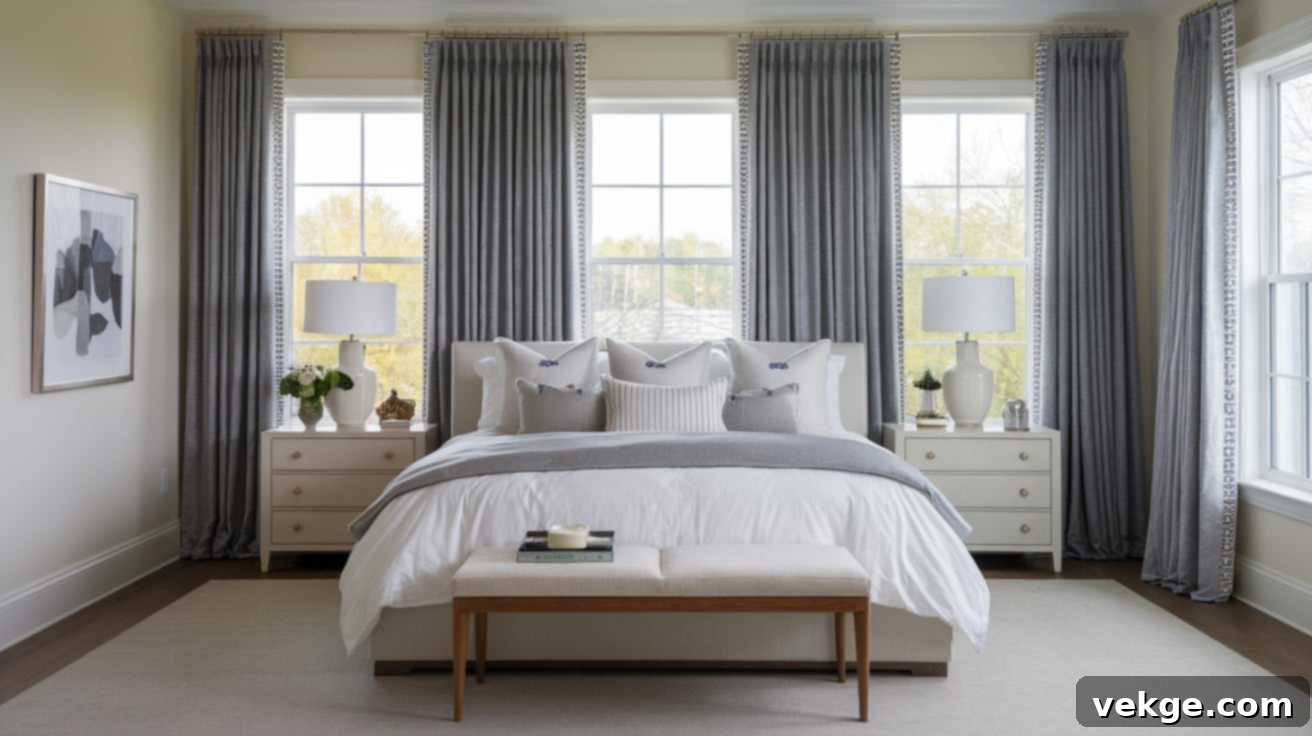
In bedrooms, three windows might be strategically placed side-by-side behind the bed, or stretch across an entire wall to enhance natural illumination. This particular setup presents an excellent opportunity to cultivate a calm, restful environment through the use of layered curtains. Consider installing blackout panels as the primary layer for superior nighttime privacy and effective light blocking, ensuring an undisturbed sleep. Complement these with soft, sheer curtains as an inner layer, perfect for diffusing bright morning light without sacrificing brightness entirely.
For a cohesive and tranquil bedroom aesthetic, choose curtain colors that beautifully complement your existing bedding or rug. If the windows are set relatively low on the wall, a clever design trick is to mount the curtain rod higher than usual. This visual strategy draws the eye upward, creating the illusion of taller walls and a more expansive room. In more confined bedroom spaces, opting for slim curtain rods and lighter, less voluminous fabrics can prevent the window treatment from feeling too heavy or overwhelming the room.
Home Offices or Dedicated Reading Corners
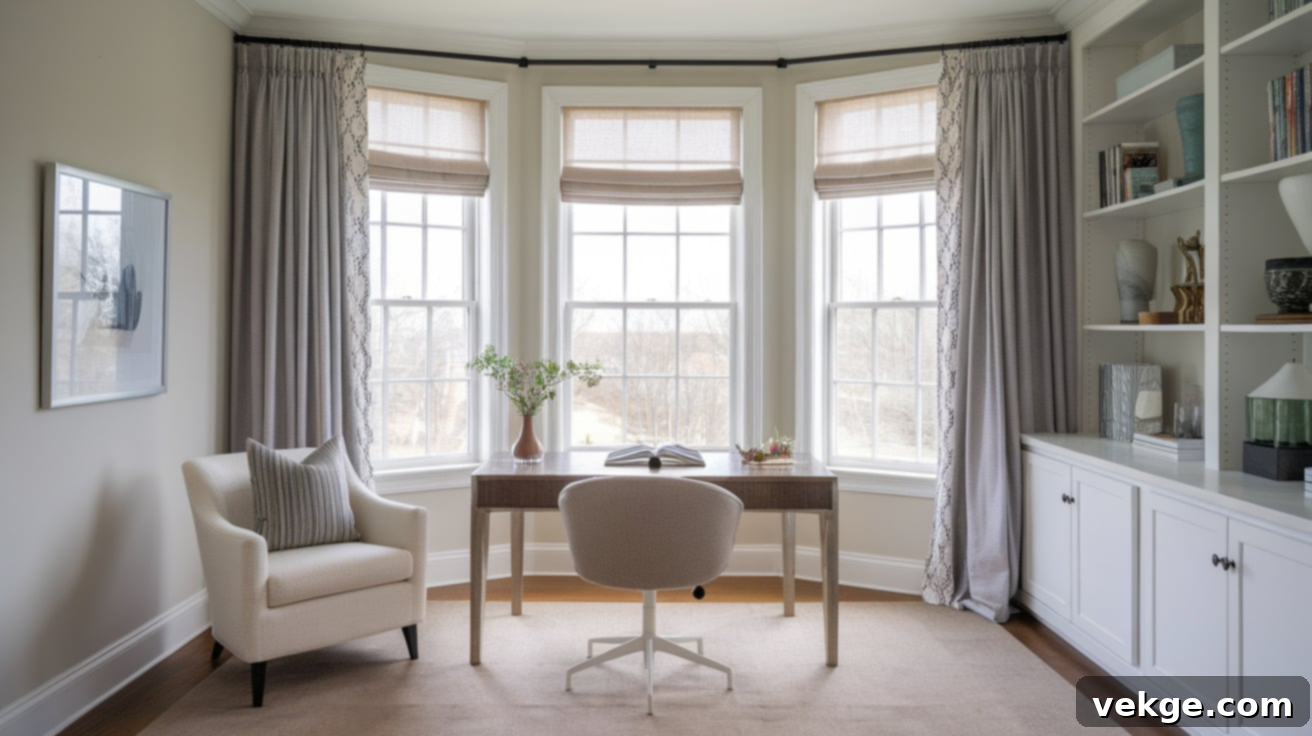
In a home office or a dedicated reading nook, three windows are invaluable for flooding the space with natural daylight, making it feel brighter, more energetic, and more open. However, prolonged or direct sunlight can be disruptive, necessitating a highly flexible window treatment solution. A practical approach is to employ sheer curtains for everyday daytime use, allowing ample light while reducing glare. For late afternoon sun or enhanced privacy, heavier panels can be drawn over the sheers.
Another excellent option for this type of space is to combine roller shades with curtains. The shades provide precise light control, while the curtains add softness and style. To maintain a focused and uncluttered environment, keep the curtain design simple and understated. This ensures that the window treatment doesn’t distract from your desk, bookshelves, or overall workspace. Opt for light, breathable fabrics and soft, neutral tones to avoid visual clutter and promote concentration.
Creative Curtain Ideas for Three Windows
Dressing three windows on the same wall provides a variety of appealing options, allowing you to tailor the look to your personal style, the specific layout of your room, and your desired level of light control and privacy. Here are four smart and popular ways to approach their setup:
1. One Continuous Rod Across All Windows
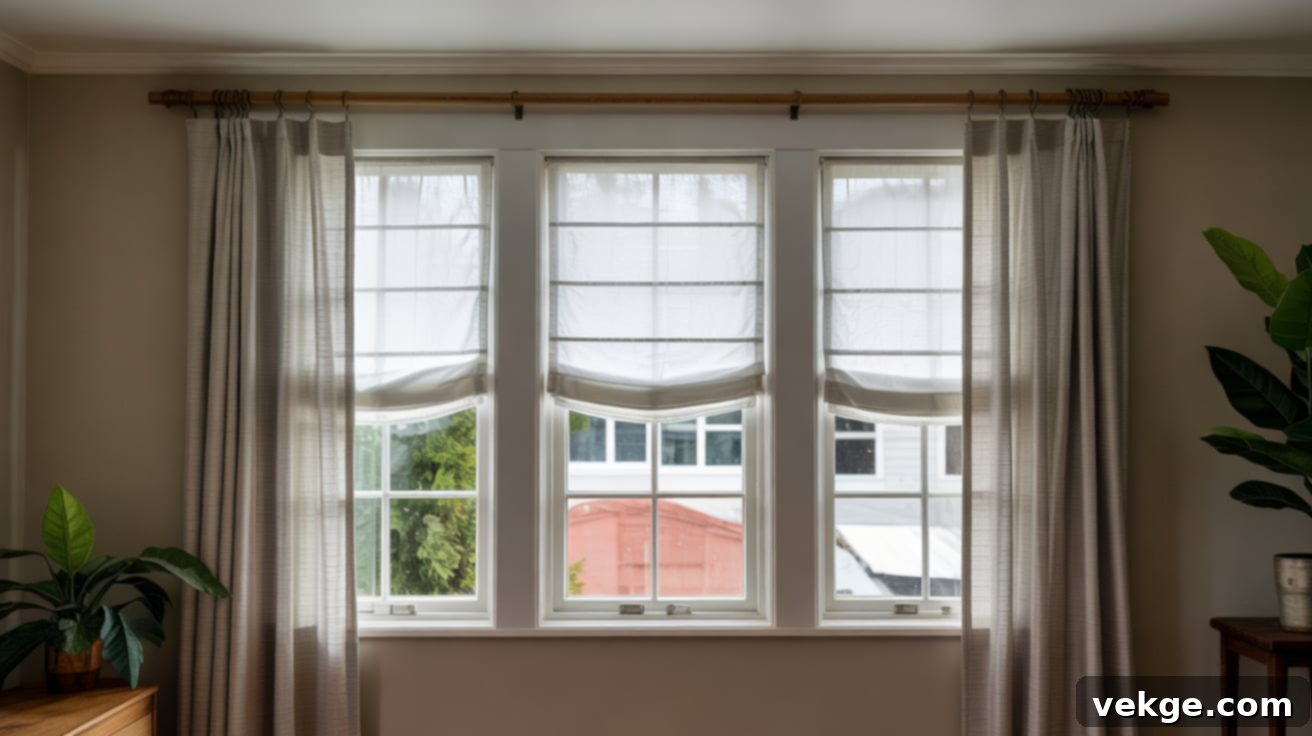
Utilizing a single, long curtain rod that stretches across the entire span of the three windows creates a wonderfully smooth, unified, and expansive look. This method is particularly effective when the windows are positioned relatively close together, and your design goal is to hang wide curtain panels at the outermost ends or strategically between each window. It maintains a clean, minimalist design while efficiently covering all three windows with a cohesive flow. To prevent sagging, especially with longer rods and heavier fabrics, it is crucial to use robust wall brackets and to incorporate at least one or more center support brackets, depending on the total length of the rod. This option is highly versatile, working equally well with both light sheers and more substantial, heavy panels, allowing you to precisely control privacy and light levels as needed.
2. Individual Panels for Each Window
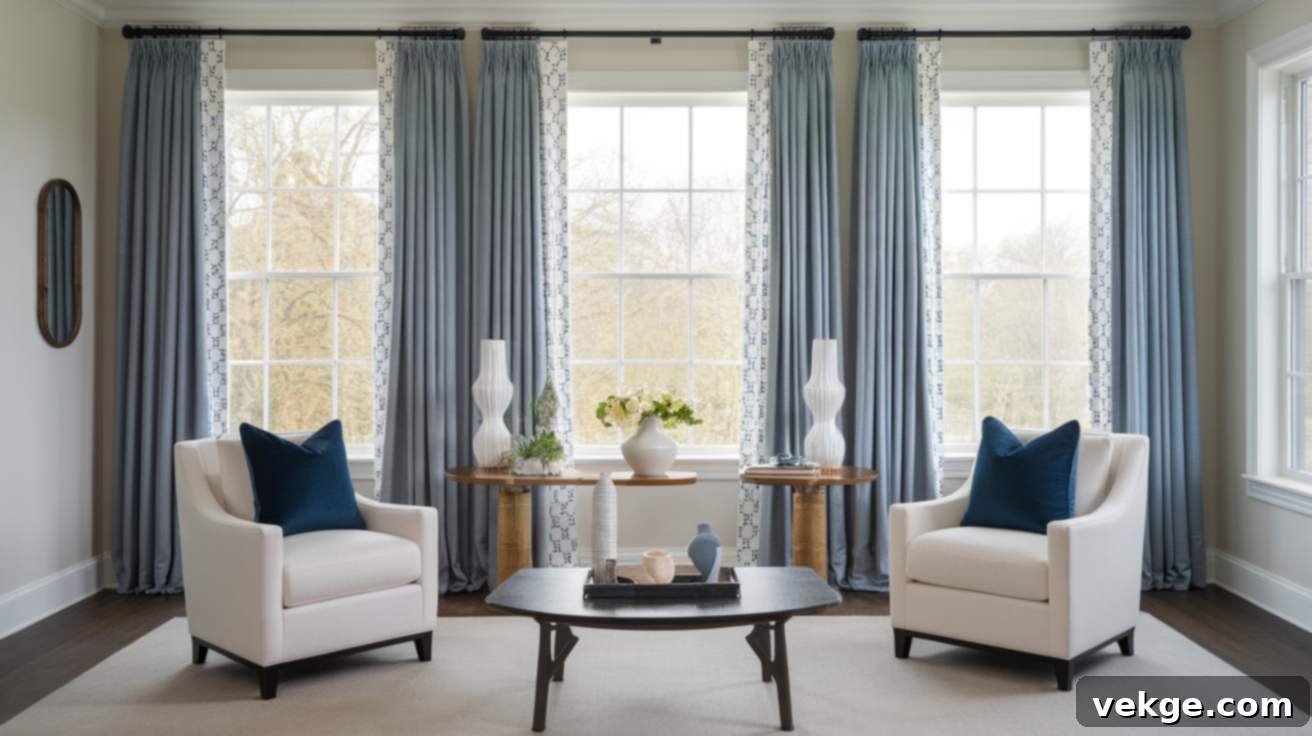
Instead of unifying all three windows under one continuous rod, you can opt to hang separate, individual curtain panels for each window. This approach offers significant flexibility, as it allows you to open or close each window’s treatment independently, which is highly advantageous in rooms where sunlight may hit different windows at various times throughout the day. Aesthetically, this method helps to visually break up a long wall, giving each window its own defined space and character. When choosing this setup, ensure that you select matching rods for all windows and maintain consistent curtain lengths across all panels to achieve a balanced and harmonious overall look. This practical setup provides you with enhanced control over the amount of light entering the room and allows for more nuanced adjustments.
3. Elegant Double-Layered Curtains

Layering curtains is an exceptionally clever and functional way to maximize the utility and aesthetic appeal of your triple-window space. This method allows you to install sheer panels as the innermost layer, providing soft, diffused natural light during the daytime while maintaining a degree of privacy. For enhanced privacy at night or for complete light blockage, you can add thicker, more opaque outer panels. This dual-layer setup offers unparalleled flexibility, allowing you to easily adjust light and privacy levels throughout the day without compromising on an airy, inviting feel.
To implement this design, you will need a specialized double curtain rod system, or alternatively, two individual rods mounted one directly in front of the other. For optimal functionality and ease of use, select a light, breathable fabric for the inner sheer layer and a slightly heavier material for the outer panels. This combination ensures smooth operation when opening and closing each layer, creating a versatile and sophisticated window treatment.
4. Dramatic Full-Length Panels
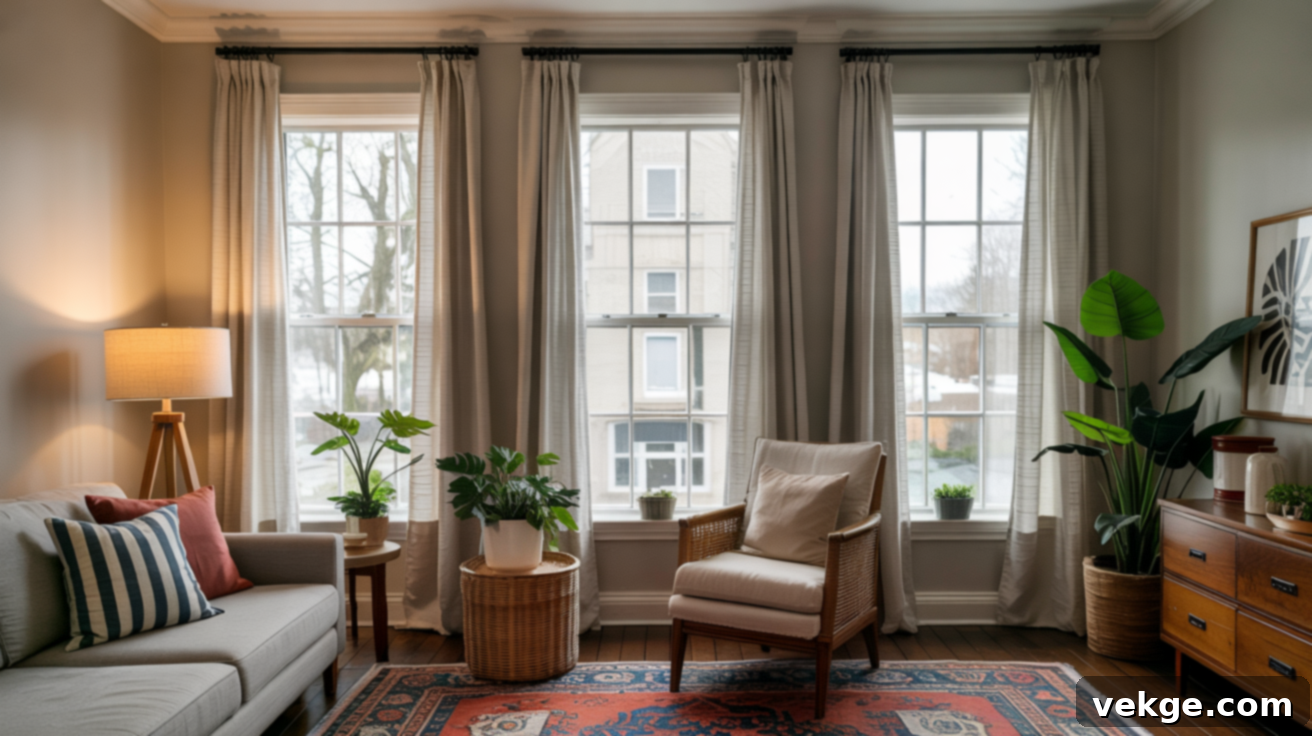
Hanging curtains that extend from just below the ceiling all the way down to the floor is a highly effective design strategy that instantly makes your space feel significantly taller, more expansive, and exquisitely put-together. This approach is particularly impactful for three windows positioned on a large wall, as it helps to visually stretch the vertical lines of the room, creating an illusion of grandeur and increased ceiling height. To achieve the best effect, use longer panels that extend at least a few inches past the window frame on both sides. This generous width ensures that the curtains can neatly stack back when open, maximizing natural light, and fully cover the glass when closed, providing complete privacy and light control. Full-length panels also introduce a beautiful sense of flow and luxurious drape, making them an ideal choice for rooms where a tidy, refined, and finished aesthetic is highly desired.
Step-by-Step Guide to Hanging Curtains on Three Windows
Hanging curtains correctly can instantly add warmth, texture, and style to any room. When dealing with three windows, precision is key for a cohesive look. Here’s a simple, step-by-step guide to ensure your triple window treatment is flawless and gives your space a fresh, updated appearance.
Step 1 – Precisely Measure Your Full Window Area
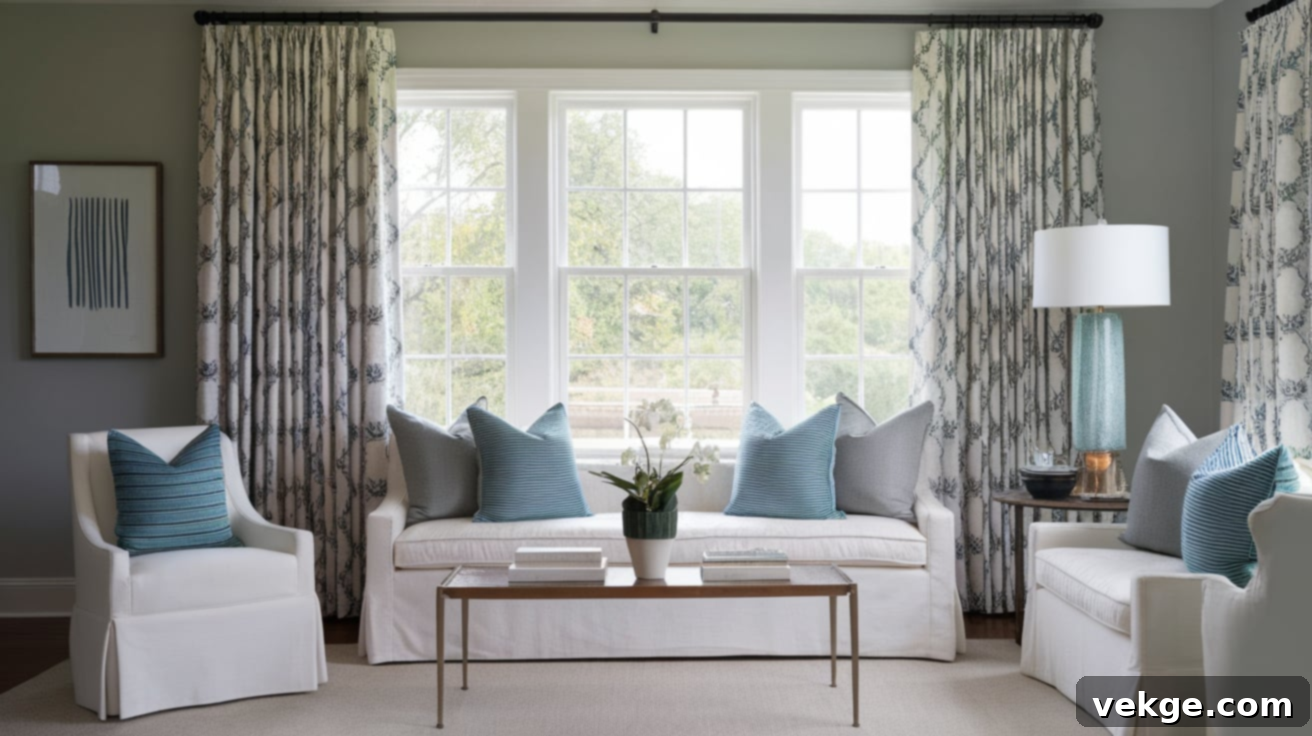
Begin by meticulously measuring the entire combined width of all three windows, making sure to include any existing trim or molding that frames them. Next, measure the height from the very top of your window frame (or your desired rod placement point) down to where you want the curtains to end. This could be just above the windowsill, precisely at floor level, or even slightly “kissing” the floor for a more relaxed puddle effect. It is absolutely crucial to measure from the exact same point on each window for consistency and to ensure a perfectly level installation. For a dramatic effect that makes the room feel taller, consider mounting the rod several inches above the window frame, extending the curtain’s perceived height.
Don’t overlook any potential obstructions like radiators, furniture, or existing window hardware that might influence your measurements or curtain length. Accurate measurements are the cornerstone of a successful installation, guaranteeing that your curtains fit flawlessly and hang exactly as you envision them, creating a truly custom look.
Step 2 – Select the Right Rod Setup for Your Design

When selecting your curtain rod setup, carefully consider both the aesthetic style and the desired functionality for your space. If your goal is a clean, unified, and expansive look, a single, continuous rod that spans across all three windows is an excellent choice. This creates a cohesive visual line and simplifies the hanging process for wide panels.
Alternatively, if you prefer more granular control over each window or want to add architectural interest, you can opt to break the treatment into smaller sections with individual rods for each window. This offers greater flexibility in terms of curtain styles and can be particularly effective in rooms with varying window sizes or unique placements. Regardless of your choice, ensure you select a sturdy rod that is capable of supporting the full weight of your chosen curtains, especially if they are made from heavier fabrics. For a contemporary or industrial feel, choose a minimalist rod design in materials like matte black or brushed nickel.
Step 3 – Thoughtfully Choose Your Curtains
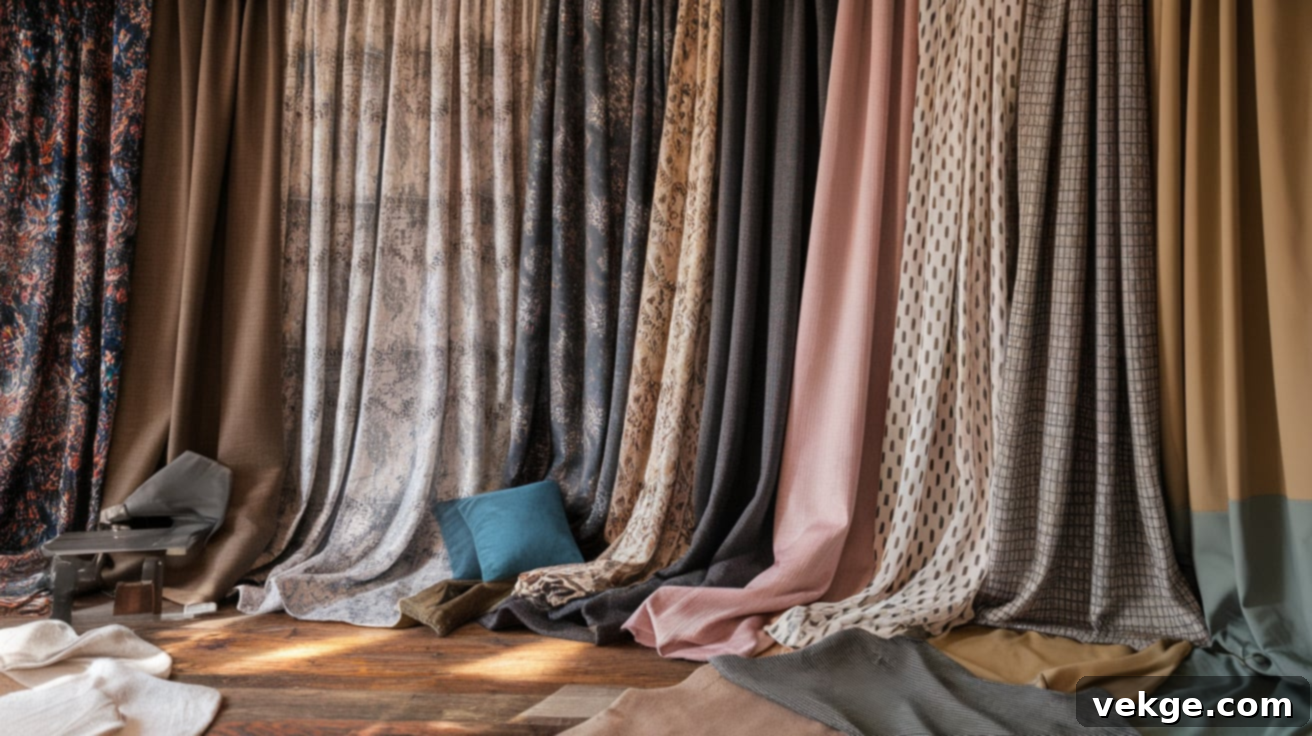
The selection of the right curtains hinges on both their functional purpose and their aesthetic contribution to the room. Begin by considering the fabric weight and opacity: heavier, thicker curtains (like velvet or blackout liners) offer superior privacy and light-blocking capabilities, ideal for bedrooms or media rooms. Lighter fabrics (such as sheer linen or airy cotton) provide a breezy, casual look, perfect for letting in diffused light in living areas or home offices.
Double-check your curtain measurements to ensure they align with your desired length – whether a crisp sill-length, a dramatic floor-length, or a subtle “break” where the fabric gently touches the floor. Next, decide on the number of panels. Two panels per window is a common choice for a balanced, symmetrical appearance, allowing curtains to open from the center. For wider windows or a more luxurious, relaxed style, consider using three panels per window, which provides extra fullness and a richer drape when closed. Finally, choose a color or pattern that beautifully complements your room’s existing decor, tying all elements together.
Step 4 – Precisely Mark Your Hanging Points
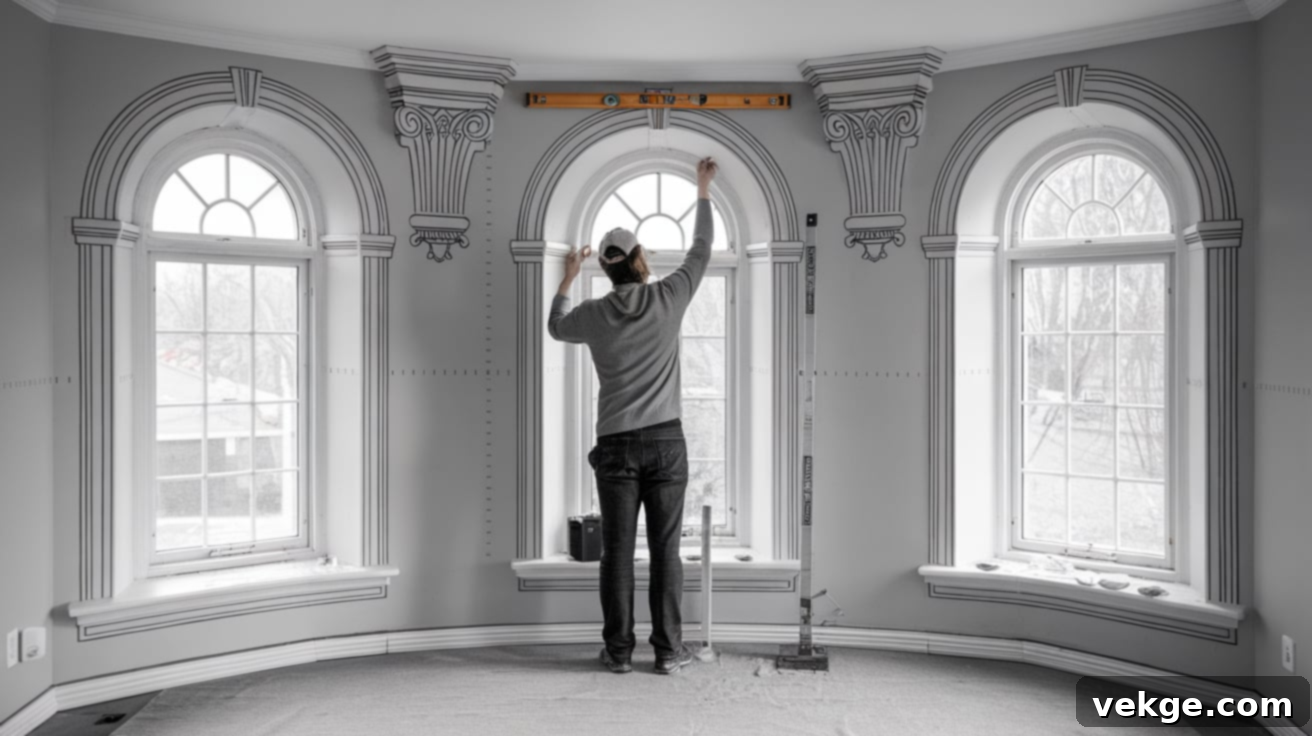
To guarantee that your curtains hang evenly and professionally across all three windows, accurate marking of your bracket installation points is essential. A general rule of thumb is to position the brackets a minimum of 4 to 6 inches above the window frame. This extra height creates the illusion of taller windows and adds an elegant, elongated appearance to the entire wall. Additionally, extend the brackets beyond the edges of the window frame, typically 4 to 12 inches on each side. This crucial extension ensures that when the curtains are fully drawn open, they can stack neatly off to the sides, maximizing the natural light entering the room and preventing them from obscuring any part of the window glass.
Always use a level to ensure your marks are perfectly aligned horizontally across all three windows. This meticulous attention to detail is key for a uniform, professional finish. Double-check all your measurements and markings before proceeding to install any hardware.
Step 5 – Securely Install Brackets and Rods
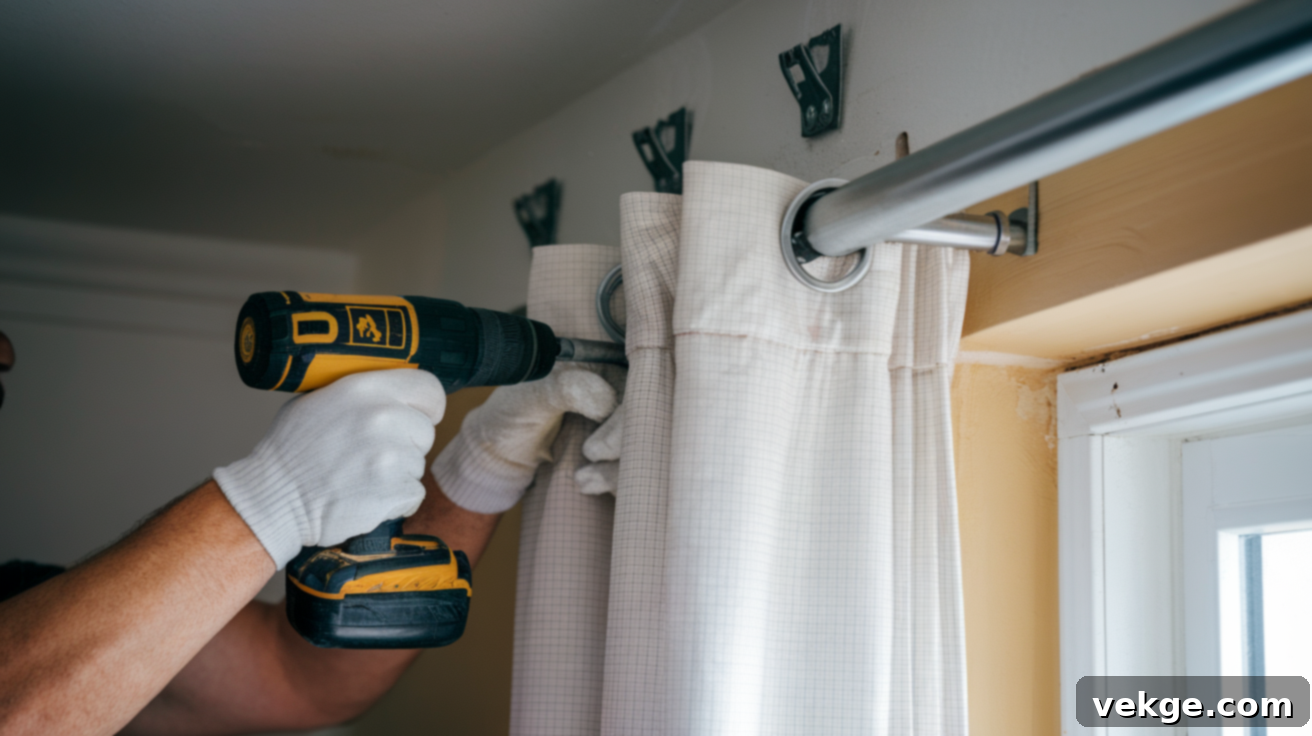
With your precise markings in place, it’s time to install the curtain brackets. If you are hanging heavy curtains or drilling into drywall, it is highly recommended to use appropriate wall anchors to ensure the brackets are securely fastened and can withstand the weight over time. Once all brackets are firmly installed, carefully attach the curtain rod. Before hanging any fabric, ensure the rod is perfectly level and stable across its entire span. If you are using a very long rod for all three windows, remember to install center support brackets to prevent any future sagging, which can ruin the aesthetic. For adjustable rods, ensure they are set to the correct length and tightened to maintain stability.
Double-check that all brackets are robustly fastened to prevent any drooping or uneven hanging issues. With the entire hardware setup aligned and secure, you are now ready to move on to the satisfying task of hanging your chosen curtains.
Step 6 – Hang and Meticulously Adjust Your Curtains
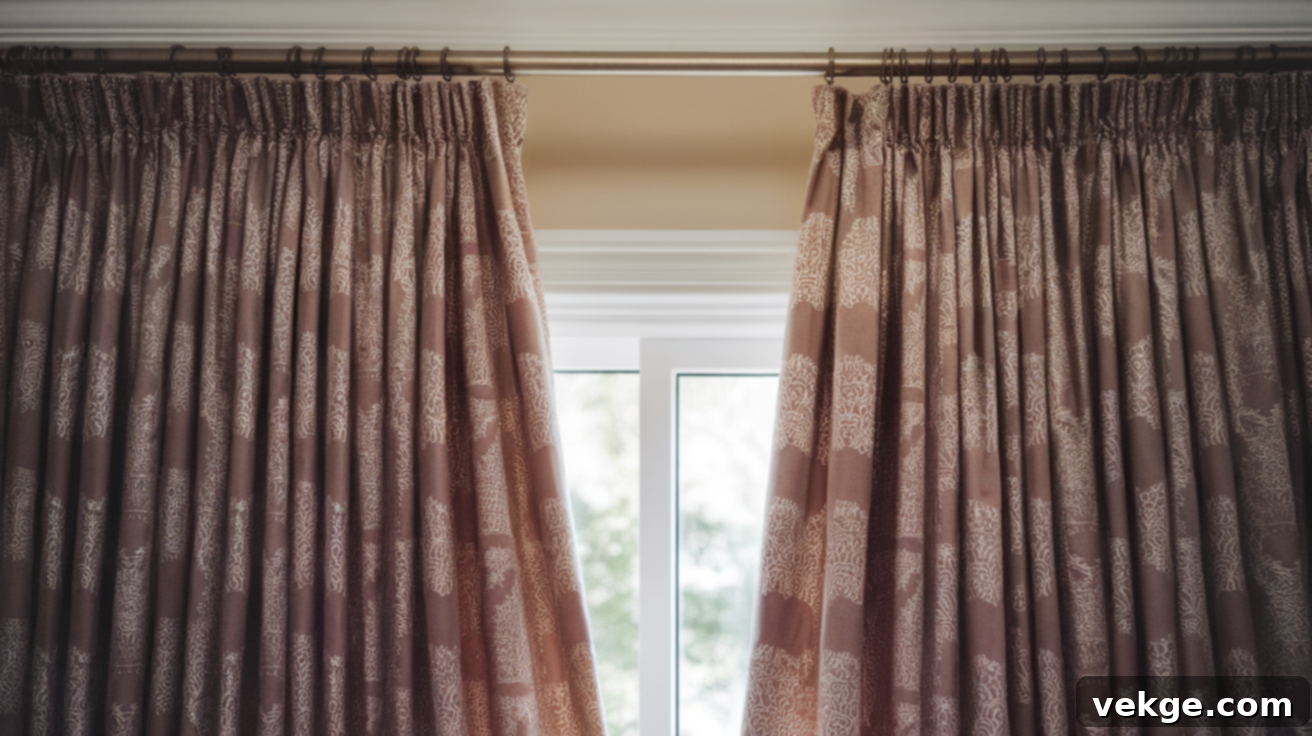
Once your rod is securely in place, carefully slide your curtain panels onto the rod. If your curtains feature specific heading styles like grommets, rod pockets, or pinch pleats, ensure they are correctly threaded or attached. Take the time to adjust each panel, ensuring they fall evenly and symmetrically on both sides of each window. If your curtains have pleats, gently arrange them to ensure they are properly formed and that the fabric drapes smoothly and beautifully.
Test the curtain’s movement along the rod, making sure it slides easily without snagging. Adjust any hooks, rings, or clips as necessary to achieve fluid motion. Finally, take a step back and survey the entire arrangement from a distance. Evaluate the overall look, confirming that the curtains are evenly distributed, perfectly aligned across all three windows, and create the desired aesthetic. Once satisfied, step back and truly enjoy your newly decorated and beautifully treated space!
Curtain Style Ideas That Seamlessly Integrate
Regardless of your personal interior design preferences, thoughtfully chosen curtains are an exceptional way to elevate a room’s aesthetic and functional appeal. Here are some distinct style ideas to help you select the best curtains for your unique space:
1. Clean and Simple for Modern Elegance
For those who appreciate a sleek, modern, and minimalist look, opt for curtains characterized by light colors, smooth fabrics, and impeccably clean lines. Neutral shades such as crisp whites, warm beiges, soft grays, or even muted pastels are perfect for cultivating an airy, understated, and uncluttered atmosphere. Ideal fabric choices include sheer linen, light cotton, or a subtle polyester blend, which maintain a fresh and inviting feel without adding visual weight. The core principle here is simplicity; therefore, avoid busy patterns, heavy textures, or excessive embellishments. With clean, well-tailored curtains, your space will feel open, serene, and effortlessly sophisticated, making this an excellent option for contemporary, Scandinavian-inspired, or even transitional rooms.
2. Warm and Cozy for Inviting Comfort
To create a cozier, more inviting, and comforting atmosphere, select curtains made from soft, tactile textures like brushed linen, cotton blends, or even light wool. Styles featuring relaxed pleats or simple, flowing folds help to evoke a comfortable, homely, and lived-in feel. Choose warm, earthy colors such as terracotta, muted oranges, deep reds, or rich browns to add depth, richness, and a sense of enveloping warmth to the room. This style is exceptionally well-suited for living rooms, family rooms, or bedrooms, where comfort, relaxation, and an intimate ambiance are top priorities. The gentle texture of the fabric, combined with a relaxed curtain style, naturally creates a warm and inviting setting, perfect for unwinding after a long day.
3. Bold and Rich for Dramatic Impact
If your aim is to make a powerful design statement and infuse your room with luxury and drama, opt for curtains crafted from thicker, more substantial fabrics, in deeper, more saturated tones. Wide, generous panels are key for achieving a full-coverage, opulent look. Heavy velvets, luxurious silks, or rich cottons in bold, striking colors like deep navy, emerald green, charcoal gray, or mustard yellow will undoubtedly create a dramatic and sophisticated effect. These types of curtains not only excel at blocking out light and providing superior insulation but also serve as an undeniable focal point in the room, commanding attention. Wide panels further enhance the sense of grandeur and can visually increase the perceived height of a room. This style works particularly well in more formal spaces, such as elegant dining rooms, grand living rooms, or luxurious master bedrooms, where you desire to convey a sense of sophistication, opulence, and refined taste.
4. Fun and Laid-Back for Playful Charm
To inject a touch of cheerful charm and playful personality into your space, consider curtains featuring fun prints, engaging patterns, or soft, inviting colors. Opt for whimsical floral patterns, classic stripes, geometric designs, or abstract motifs in pastel shades, light blues, cheerful yellows, or soft greens for a more relaxed and lighthearted aesthetic. This style immediately brings a sense of joy and lightheartedness to a room and is perfectly suited for spaces such as kitchens, children’s rooms, creative studios, or casual living areas. Pairing the right vibrant or charming pattern with light, airy fabrics like sheer cotton or crisp linen ensures the look remains fresh, inviting, and never overwhelming. It’s an excellent option if you’re looking to add unique personality and a dash of character to a space without sacrificing a bright and open feel.
Choosing Fabric and Color: Essential Considerations
The careful selection of the right fabric and color for your curtains is a pivotal decision that will profoundly influence both the aesthetic appeal and the practical functionality of your window treatments. Your choices need to align with your personal style while also effectively managing light and privacy according to your specific needs for each room. Here are two critical factors to focus on when making these important selections:
Thoughtful Consideration of Light and Privacy Needs
When selecting curtains, it’s paramount to think about the primary function they will serve in a given room. For instance, if you are adding curtains to a bedroom, blackout panels are an exceptionally smart and practical choice. These specially designed curtains effectively block out virtually all incoming light, crucial for quality sleep, and provide superior privacy, especially during the nighttime hours. They also offer excellent insulation, helping to regulate room temperature.
Conversely, for rooms that benefit from abundant natural sunlight, such as a living room, kitchen, or a home office, sheer or semi-sheer curtains are often a more suitable and desirable choice. These fabrics allow filtered light to gently illuminate the space while still offering a degree of coverage and reducing harsh glare. For ultimate versatility, consider layering both types of curtains. A double rod setup (as discussed earlier) allows you to hang sheers for daytime use and then draw heavier, opaque panels for evening privacy or full light blockage, providing complete control over the ambiance and functionality of the room.
Harmonious Matching with Your Existing Space
To create a cohesive and visually pleasing interior, it is essential to select curtain colors that complement and harmonize with your existing room decor. Take a comprehensive look at the dominant colors in your walls, sofa, area rug, bedding, or any other significant decorative elements. If your space features a palette of soft, muted colors, choosing curtains in a similar tone can help maintain a calm, balanced, and serene look, creating a sense of understated elegance.
Conversely, if the room currently feels somewhat plain or lacks visual interest, curtains in a darker, warmer, or more vibrant color can serve as a striking accent, adding depth and personality. The overarching goal is to ensure that your curtains integrate seamlessly into the room, enhancing its overall design rather than standing out jarringly or feeling out of place. This thoughtful coordination ensures that the room looks and feels more finished, intentional, and inviting, creating a truly unified aesthetic.
Rods and Hardware to Elevate Your Curtains
The selection of the right curtain hardware is just as critical as choosing the curtains themselves, particularly when you are outfitting a set of three windows. High-quality, appropriate hardware ensures both the functional integrity and the aesthetic appeal of your window treatment. If your design plan involves layered curtains—such as delicate sheers positioned behind heavier, more opaque panels—a double rod setup is undoubtedly the most effective and practical option. This configuration allows you to operate each layer independently and effortlessly, providing maximum flexibility for light control and privacy without any hassle.
For wider walls or a unified look across all three windows, extendable curtain rods are an excellent choice, as they can span significant lengths without requiring custom sizing, offering convenience and cost-effectiveness. However, it is paramount to ensure that these rods are robust and sturdy enough to adequately support the combined weight of your chosen fabrics, especially if they are heavy. To maintain long-term stability and prevent unsightly sagging, it is crucial to use strong, well-installed wall brackets and to add at least one center support bracket (or more, depending on the rod’s total length) to the middle of any long rods. This meticulous attention to hardware will keep your entire setup looking neat, secure, and professional for years to come.
Common Mistakes to Avoid When Hanging Curtains
When undertaking the task of hanging curtains, it’s surprisingly easy to make common mistakes that can significantly detract from the overall look and feel of your room. Being aware of these pitfalls beforehand can help you achieve a polished and professional finish. Here are a few common missteps to watch out for:
- Using a Rod That Bends or Droops in the Middle: A weak, flimsy, or undersized curtain rod may visibly bend or droop under the weight of the curtains, creating an uneven, unprofessional, and saggy appearance. Always invest in sturdy, high-quality rods made from appropriate materials (like steel or thick wood) that are specifically designed to support the weight of your chosen fabric. For longer spans, ensure you include adequate center support brackets.
- Hanging the Rod Too Low or the Panels Too Short: One of the most common mistakes is mounting the curtain rod too close to the top of the window frame, or using curtain panels that are simply too short. This can make the windows appear smaller, the ceilings lower, and the entire space feel cramped or unbalanced. To create an illusion of height and grandeur, always hang your curtain rod at least 4-6 inches (or even higher) above the window frame, and ensure your panels either skim the floor or gently puddle on it.
- Picking Fabric or Color That Clashes with the Room: Curtains should seamlessly complement your room’s existing decor, not clash with it or stand out jarringly. Choosing the wrong fabric texture, pattern, or color can disrupt the harmony and flow of your space, making the room feel disjointed. Take samples home, consider your room’s lighting, and ensure your curtain choice enhances, rather than detracts from, your overall design aesthetic.
- Not Adding Enough Width for Luxurious Folds When Curtains Are Closed: Many people underestimate the amount of fabric needed. Curtains require extra width (often 1.5 to 3 times the width of the window, depending on desired fullness) to create elegant, even, and luxurious folds when they are drawn closed. Panels that are too narrow will look stretched flat and skimpy, failing to provide the rich texture and visual appeal you’re likely aiming for, especially if you desire a full and opulent appearance.
Conclusion
Hanging curtains on three windows might initially seem like a daunting task, but with the right guidance and attention to detail, it doesn’t have to be overwhelming. By meticulously following these essential steps—from precise measuring and thoughtfully choosing the correct rod setup to selecting the perfect fabric and hardware, and proactively avoiding common installation mistakes—you are well on your way to achieving a polished, stylish, and utterly transformative look for any room in your home.
Whether your personal preference leans towards a clean, minimalist design that enhances an airy feel, or a bold, rich statement that exudes luxury, the right curtains can profoundly improve the overall ambiance and functional appeal of your space. With careful planning, a bit of patience, and a keen eye for detail, you’ll successfully create a window treatment setup that not only perfectly complements your home’s aesthetic but also elevates its comfort and style. Enjoy the rewarding experience of your newly upgraded windows!
Hanging curtains for a set of three windows might seem like a straightforward task, but it involves more than simply choosing attractive fabric. To achieve a truly polished and functional outcome, you need to carefully consider the window layout, select the appropriate rod setup, and ensure that everything fits perfectly and hangs evenly. The right window treatment can dramatically transform your space, whether you’re aiming for a simple, clean aesthetic or a more dramatic, layered look.
This comprehensive, step-by-step guide will walk you through the entire process. From precise measurements and selecting the ideal curtains to choosing the right hardware and executing a flawless installation, we’ll cover every detail. By the end, you’ll possess the confidence and knowledge needed to tackle your triple window treatments like a seasoned professional, enhancing both the style and comfort of your home.
Why Three Windows Demand Thoughtful Planning
When you’re dealing with three windows grouped side-by-side, the complexity of the task increases significantly. It’s not just about covering the glass; you need to consider the entire wall space, visual balance, and how the chosen window treatment will integrate with the overall room decor. Treating multiple windows as a single unit, or as distinct elements, requires a strategic approach to ensure a harmonious and appealing result.
Common Layout Challenges with Triple Windows
More extensive wall space naturally translates to a need for more fabric, longer curtain rods, and additional support brackets. Without adequate support, long rods are highly susceptible to sagging in the middle, especially when bearing the weight of heavier curtains. This can instantly detract from an otherwise beautiful setup, making it appear poorly executed and untidy.
Uneven hanging is another prevalent issue. Curtains that don’t align perfectly or fail to slide smoothly can disrupt the entire aesthetic, creating an unbalanced and unprofessional appearance. Furthermore, using panels that are too short can make the windows look awkward, unfinished, and smaller than they actually are. It’s crucial to create a balanced look that thoughtfully frames the full width and height of the window area. When executed correctly, the curtains should gracefully frame the space, enhancing its features without appearing overly bulky or too sparse.
Where You’ll Encounter Triple Window Layouts Most Often
Triple windows are a popular architectural feature, frequently appearing in key rooms where both aesthetic appeal and practical functionality are paramount. Understanding these common placements can help in planning the most effective curtain solutions:
Living Rooms with Expansive Walls

Living rooms often boast large walls featuring three windows, specifically designed to maximize natural light and create an open, inviting atmosphere. This arrangement typically forms a significant focal point in the room, necessitating a carefully considered curtain setup. A common and effective approach involves using one continuous, long rod that spans across all three windows, with wide curtain panels positioned at either end. Delicate, soft sheers can be hung in the center sections, maintaining a balanced, airy feel while still offering a degree of light control and privacy.
For a sophisticated and tidy appearance, aim for floor-length curtains. These not only draw the eye upward, making the room feel taller, but also provide a seamless flow. For added versatility, incorporate curtain tiebacks to gracefully pull the panels aside during the day, allowing maximum light penetration. To ensure visual harmony, select curtain colors that are either neutral or closely complement your existing furniture and decor, avoiding any visual clashes that could disrupt the room’s serene ambiance.
Bedrooms with Grouped Windows

In bedrooms, three windows might be strategically placed side-by-side behind the bed, or stretch across an entire wall to enhance natural illumination. This particular setup presents an excellent opportunity to cultivate a calm, restful environment through the use of layered curtains. Consider installing blackout panels as the primary layer for superior nighttime privacy and effective light blocking, ensuring an undisturbed sleep. Complement these with soft, sheer curtains as an inner layer, perfect for diffusing bright morning light without sacrificing brightness entirely.
For a cohesive and tranquil bedroom aesthetic, choose curtain colors that beautifully complement your existing bedding or rug. If the windows are set relatively low on the wall, a clever design trick is to mount the curtain rod higher than usual. This visual strategy draws the eye upward, creating the illusion of taller walls and a more expansive room. In more confined bedroom spaces, opting for slim curtain rods and lighter, less voluminous fabrics can prevent the window treatment from feeling too heavy or overwhelming the room.
Home Offices or Dedicated Reading Corners

In a home office or a dedicated reading nook, three windows are invaluable for flooding the space with natural daylight, making it feel brighter, more energetic, and more open. However, prolonged or direct sunlight can be disruptive, necessitating a highly flexible window treatment solution. A practical approach is to employ sheer curtains for everyday daytime use, allowing ample light while reducing glare. For late afternoon sun or enhanced privacy, heavier panels can be drawn over the sheers.
Another excellent option for this type of space is to combine roller shades with curtains. The shades provide precise light control, while the curtains add softness and style. To maintain a focused and uncluttered environment, keep the curtain design simple and understated. This ensures that the window treatment doesn’t distract from your desk, bookshelves, or overall workspace. Opt for light, breathable fabrics and soft, neutral tones to avoid visual clutter and promote concentration.
Creative Curtain Ideas for Three Windows
Dressing three windows on the same wall provides a variety of appealing options, allowing you to tailor the look to your personal style, the specific layout of your room, and your desired level of light control and privacy. Here are four smart and popular ways to approach their setup:
1. One Continuous Rod Across All Windows

Utilizing a single, long curtain rod that stretches across the entire span of the three windows creates a wonderfully smooth, unified, and expansive look. This method is particularly effective when the windows are positioned relatively close together, and your design goal is to hang wide curtain panels at the outermost ends or strategically between each window. It maintains a clean, minimalist design while efficiently covering all three windows with a cohesive flow. To prevent sagging, especially with longer rods and heavier fabrics, it is crucial to use robust wall brackets and to incorporate at least one or more center support brackets, depending on the total length of the rod. This option is highly versatile, working equally well with both light sheers and more substantial, heavy panels, allowing you to precisely control privacy and light levels as needed.
2. Individual Panels for Each Window

Instead of unifying all three windows under one continuous rod, you can opt to hang separate, individual curtain panels for each window. This approach offers significant flexibility, as it allows you to open or close each window’s treatment independently, which is highly advantageous in rooms where sunlight may hit different windows at various times throughout the day. Aesthetically, this method helps to visually break up a long wall, giving each window its own defined space and character. When choosing this setup, ensure that you select matching rods for all windows and maintain consistent curtain lengths across all panels to achieve a balanced and harmonious overall look. This practical setup provides you with enhanced control over the amount of light entering the room and allows for more nuanced adjustments.
3. Elegant Double-Layered Curtains

Layering curtains is an exceptionally clever and functional way to maximize the utility and aesthetic appeal of your triple-window space. This method allows you to install sheer panels as the innermost layer, providing soft, diffused natural light during the daytime while maintaining a degree of privacy. For enhanced privacy at night or for complete light blockage, you can add thicker, more opaque outer panels. This dual-layer setup offers unparalleled flexibility, allowing you to easily adjust light and privacy levels throughout the day without compromising on an airy, inviting feel.
To implement this design, you will need a specialized double curtain rod system, or alternatively, two individual rods mounted one directly in front of the other. For optimal functionality and ease of use, select a light, breathable fabric for the inner sheer layer and a slightly heavier material for the outer panels. This combination ensures smooth operation when opening and closing each layer, creating a versatile and sophisticated window treatment.
4. Dramatic Full-Length Panels

Hanging curtains that extend from just below the ceiling all the way down to the floor is a highly effective design strategy that instantly makes your space feel significantly taller, more expansive, and exquisitely put-together. This approach is particularly impactful for three windows positioned on a large wall, as it helps to visually stretch the vertical lines of the room, creating an illusion of grandeur and increased ceiling height. To achieve the best effect, use longer panels that extend at least a few inches past the window frame on both sides. This generous width ensures that the curtains can neatly stack back when open, maximizing natural light, and fully cover the glass when closed, providing complete privacy and light control. Full-length panels also introduce a beautiful sense of flow and luxurious drape, making them an ideal choice for rooms where a tidy, refined, and finished aesthetic is highly desired.
Step-by-Step Guide to Hanging Curtains on Three Windows
Hanging curtains correctly can instantly add warmth, texture, and style to any room. When dealing with three windows, precision is key for a cohesive look. Here’s a simple, step-by-step guide to ensure your triple window treatment is flawless and gives your space a fresh, updated appearance.
Step 1 – Precisely Measure Your Full Window Area

Begin by meticulously measuring the entire combined width of all three windows, making sure to include any existing trim or molding that frames them. Next, measure the height from the very top of your window frame (or your desired rod placement point) down to where you want the curtains to end. This could be just above the windowsill, precisely at floor level, or even slightly “kissing” the floor for a more relaxed puddle effect. It is absolutely crucial to measure from the exact same point on each window for consistency and to ensure a perfectly level installation. For a dramatic effect that makes the room feel taller, consider mounting the rod several inches above the window frame, extending the curtain’s perceived height.
Don’t overlook any potential obstructions like radiators, furniture, or existing window hardware that might influence your measurements or curtain length. Accurate measurements are the cornerstone of a successful installation, guaranteeing that your curtains fit flawlessly and hang exactly as you envision them, creating a truly custom look.
Step 2 – Select the Right Rod Setup for Your Design

When selecting your curtain rod setup, carefully consider both the aesthetic style and the desired functionality for your space. If your goal is a clean, unified, and expansive look, a single, continuous rod that spans across all three windows is an excellent choice. This creates a cohesive visual line and simplifies the hanging process for wide panels.
Alternatively, if you prefer more granular control over each window or want to add architectural interest, you can opt to break the treatment into smaller sections with individual rods for each window. This offers greater flexibility in terms of curtain styles and can be particularly effective in rooms with varying window sizes or unique placements. Regardless of your choice, ensure you select a sturdy rod that is capable of supporting the full weight of your chosen curtains, especially if they are made from heavier fabrics. For a contemporary or industrial feel, choose a minimalist rod design in materials like matte black or brushed nickel.
Step 3 – Thoughtfully Choose Your Curtains

The selection of the right curtains hinges on both their functional purpose and their aesthetic contribution to the room. Begin by considering the fabric weight and opacity: heavier, thicker curtains (like velvet or blackout liners) offer superior privacy and light-blocking capabilities, ideal for bedrooms or media rooms. Lighter fabrics (such as sheer linen or airy cotton) provide a breezy, casual look, perfect for letting in diffused light in living areas or home offices.
Double-check your curtain measurements to ensure they align with your desired length – whether a crisp sill-length, a dramatic floor-length, or a subtle “break” where the fabric gently touches the floor. Next, decide on the number of panels. Two panels per window is a common choice for a balanced, symmetrical appearance, allowing curtains to open from the center. For wider windows or a more luxurious, relaxed style, consider using three panels per window, which provides extra fullness and a richer drape when closed. Finally, choose a color or pattern that beautifully complements your room’s existing decor, tying all elements together.
Step 4 – Precisely Mark Your Hanging Points

To guarantee that your curtains hang evenly and professionally across all three windows, accurate marking of your bracket installation points is essential. A general rule of thumb is to position the brackets a minimum of 4 to 6 inches above the window frame. This extra height creates the illusion of taller windows and adds an elegant, elongated appearance to the entire wall. Additionally, extend the brackets beyond the edges of the window frame, typically 4 to 12 inches on each side. This crucial extension ensures that when the curtains are fully drawn open, they can stack neatly off to the sides, maximizing the natural light entering the room and preventing them from obscuring any part of the window glass.
Always use a level to ensure your marks are perfectly aligned horizontally across all three windows. This meticulous attention to detail is key for a uniform, professional finish. Double-check all your measurements and markings before proceeding to install any hardware.
Step 5 – Securely Install Brackets and Rods

With your precise markings in place, it’s time to install the curtain brackets. If you are hanging heavy curtains or drilling into drywall, it is highly recommended to use appropriate wall anchors to ensure the brackets are securely fastened and can withstand the weight over time. Once all brackets are firmly installed, carefully attach the curtain rod. Before hanging any fabric, ensure the rod is perfectly level and stable across its entire span. If you are using a very long rod for all three windows, remember to install center support brackets to prevent any future sagging, which can ruin the aesthetic. For adjustable rods, ensure they are set to the correct length and tightened to maintain stability.
Double-check that all brackets are robustly fastened to prevent any drooping or uneven hanging issues. With the entire hardware setup aligned and secure, you are now ready to move on to the satisfying task of hanging your chosen curtains.
Step 6 – Hang and Meticulously Adjust Your Curtains

Once your rod is securely in place, carefully slide your curtain panels onto the rod. If your curtains feature specific heading styles like grommets, rod pockets, or pinch pleats, ensure they are correctly threaded or attached. Take the time to adjust each panel, ensuring they fall evenly and symmetrically on both sides of each window. If your curtains have pleats, gently arrange them to ensure they are properly formed and that the fabric drapes smoothly and beautifully.
Test the curtain’s movement along the rod, making sure it slides easily without snagging. Adjust any hooks, rings, or clips as necessary to achieve fluid motion. Finally, take a step back and survey the entire arrangement from a distance. Evaluate the overall look, confirming that the curtains are evenly distributed, perfectly aligned across all three windows, and create the desired aesthetic. Once satisfied, step back and truly enjoy your newly decorated and beautifully treated space!
Curtain Style Ideas That Seamlessly Integrate
Regardless of your personal interior design preferences, thoughtfully chosen curtains are an exceptional way to elevate a room’s aesthetic and functional appeal. Here are some distinct style ideas to help you select the best curtains for your unique space:
1. Clean and Simple for Modern Elegance
For those who appreciate a sleek, modern, and minimalist look, opt for curtains characterized by light colors, smooth fabrics, and impeccably clean lines. Neutral shades such as crisp whites, warm beiges, soft grays, or even muted pastels are perfect for cultivating an airy, understated, and uncluttered atmosphere. Ideal fabric choices include sheer linen, light cotton, or a subtle polyester blend, which maintain a fresh and inviting feel without adding visual weight. The core principle here is simplicity; therefore, avoid busy patterns, heavy textures, or excessive embellishments. With clean, well-tailored curtains, your space will feel open, serene, and effortlessly sophisticated, making this an excellent option for contemporary, Scandinavian-inspired, or even transitional rooms.
2. Warm and Cozy for Inviting Comfort
To create a cozier, more inviting, and comforting atmosphere, select curtains made from soft, tactile textures like brushed linen, cotton blends, or even light wool. Styles featuring relaxed pleats or simple, flowing folds help to evoke a comfortable, homely, and lived-in feel. Choose warm, earthy colors such as terracotta, muted oranges, deep reds, or rich browns to add depth, richness, and a sense of enveloping warmth to the room. This style is exceptionally well-suited for living rooms, family rooms, or bedrooms, where comfort, relaxation, and an intimate ambiance are top priorities. The gentle texture of the fabric, combined with a relaxed curtain style, naturally creates a warm and inviting setting, perfect for unwinding after a long day.
3. Bold and Rich for Dramatic Impact
If your aim is to make a powerful design statement and infuse your room with luxury and drama, opt for curtains crafted from thicker, more substantial fabrics, in deeper, more saturated tones. Wide, generous panels are key for achieving a full-coverage, opulent look. Heavy velvets, luxurious silks, or rich cottons in bold, striking colors like deep navy, emerald green, charcoal gray, or mustard yellow will undoubtedly create a dramatic and sophisticated effect. These types of curtains not only excel at blocking out light and providing superior insulation but also serve as an undeniable focal point in the room, commanding attention. Wide panels further enhance the sense of grandeur and can visually increase the perceived height of a room. This style works particularly well in more formal spaces, such as elegant dining rooms, grand living rooms, or luxurious master bedrooms, where you desire to convey a sense of sophistication, opulence, and refined taste.
4. Fun and Laid-Back for Playful Charm
To inject a touch of cheerful charm and playful personality into your space, consider curtains featuring fun prints, engaging patterns, or soft, inviting colors. Opt for whimsical floral patterns, classic stripes, geometric designs, or abstract motifs in pastel shades, light blues, cheerful yellows, or soft greens for a more relaxed and lighthearted aesthetic. This style immediately brings a sense of joy and lightheartedness to a room and is perfectly suited for spaces such as kitchens, children’s rooms, creative studios, or casual living areas. Pairing the right vibrant or charming pattern with light, airy fabrics like sheer cotton or crisp linen ensures the look remains fresh, inviting, and never overwhelming. It’s an excellent option if you’re looking to add unique personality and a dash of character to a space without sacrificing a bright and open feel.
Choosing Fabric and Color: Essential Considerations
The careful selection of the right fabric and color for your curtains is a pivotal decision that will profoundly influence both the aesthetic appeal and the practical functionality of your window treatments. Your choices need to align with your personal style while also effectively managing light and privacy according to your specific needs for each room. Here are two critical factors to focus on when making these important selections:
Thoughtful Consideration of Light and Privacy Needs
When selecting curtains, it’s paramount to think about the primary function they will serve in a given room. For instance, if you are adding curtains to a bedroom, blackout panels are an exceptionally smart and practical choice. These specially designed curtains effectively block out virtually all incoming light, crucial for quality sleep, and provide superior privacy, especially during the nighttime hours. They also offer excellent insulation, helping to regulate room temperature.
Conversely, for rooms that benefit from abundant natural sunlight, such as a living room, kitchen, or a home office, sheer or semi-sheer curtains are often a more suitable and desirable choice. These fabrics allow filtered light to gently illuminate the space while still offering a degree of coverage and reducing harsh glare. For ultimate versatility, consider layering both types of curtains. A double rod setup (as discussed earlier) allows you to hang sheers for daytime use and then draw heavier, opaque panels for evening privacy or full light blockage, providing complete control over the ambiance and functionality of the room.
Harmonious Matching with Your Existing Space
To create a cohesive and visually pleasing interior, it is essential to select curtain colors that complement and harmonize with your existing room decor. Take a comprehensive look at the dominant colors in your walls, sofa, area rug, bedding, or any other significant decorative elements. If your space features a palette of soft, muted colors, choosing curtains in a similar tone can help maintain a calm, balanced, and serene look, creating a sense of understated elegance.
Conversely, if the room currently feels somewhat plain or lacks visual interest, curtains in a darker, warmer, or more vibrant color can serve as a striking accent, adding depth and personality. The overarching goal is to ensure that your curtains integrate seamlessly into the room, enhancing its overall design rather than standing out jarringly or feeling out of place. This thoughtful coordination ensures that the room looks and feels more finished, intentional, and inviting, creating a truly unified aesthetic.
Rods and Hardware to Elevate Your Curtains
The selection of the right curtain hardware is just as critical as choosing the curtains themselves, particularly when you are outfitting a set of three windows. High-quality, appropriate hardware ensures both the functional integrity and the aesthetic appeal of your window treatment. If your design plan involves layered curtains—such as delicate sheers positioned behind heavier, more opaque panels—a double rod setup is undoubtedly the most effective and practical option. This configuration allows you to operate each layer independently and effortlessly, providing maximum flexibility for light control and privacy without any hassle.
For wider walls or a unified look across all three windows, extendable curtain rods are an excellent choice, as they can span significant lengths without requiring custom sizing, offering convenience and cost-effectiveness. However, it is paramount to ensure that these rods are robust and sturdy enough to adequately support the combined weight of your chosen fabrics, especially if they are heavy. To maintain long-term stability and prevent unsightly sagging, it is crucial to use strong, well-installed wall brackets and to add at least one center support bracket (or more, depending on the rod’s total length) to the middle of any long rods. This meticulous attention to hardware will keep your entire setup looking neat, secure, and professional for years to come.
Common Mistakes to Avoid When Hanging Curtains
When undertaking the task of hanging curtains, it’s surprisingly easy to make common mistakes that can significantly detract from the overall look and feel of your room. Being aware of these pitfalls beforehand can help you achieve a polished and professional finish. Here are a few common missteps to watch out for:
- Using a Rod That Bends or Droops in the Middle: A weak, flimsy, or undersized curtain rod may visibly bend or droop under the weight of the curtains, creating an uneven, unprofessional, and saggy appearance. Always invest in sturdy, high-quality rods made from appropriate materials (like steel or thick wood) that are specifically designed to support the weight of your chosen fabric. For longer spans, ensure you include adequate center support brackets.
- Hanging the Rod Too Low or the Panels Too Short: One of the most common mistakes is mounting the curtain rod too close to the top of the window frame, or using curtain panels that are simply too short. This can make the windows appear smaller, the ceilings lower, and the entire space feel cramped or unbalanced. To create an illusion of height and grandeur, always hang your curtain rod at least 4-6 inches (or even higher) above the window frame, and ensure your panels either skim the floor or gently puddle on it.
- Picking Fabric or Color That Clashes with the Room: Curtains should seamlessly complement your room’s existing decor, not clash with it or stand out jarringly. Choosing the wrong fabric texture, pattern, or color can disrupt the harmony and flow of your space, making the room feel disjointed. Take samples home, consider your room’s lighting, and ensure your curtain choice enhances, rather than detracts from, your overall design aesthetic.
- Not Adding Enough Width for Luxurious Folds When Curtains Are Closed: Many people underestimate the amount of fabric needed. Curtains require extra width (often 1.5 to 3 times the width of the window, depending on desired fullness) to create elegant, even, and luxurious folds when they are drawn closed. Panels that are too narrow will look stretched flat and skimpy, failing to provide the rich texture and visual appeal you’re likely aiming for, especially if you desire a full and opulent appearance.
Conclusion
Hanging curtains on three windows might initially seem like a daunting task, but with the right guidance and attention to detail, it doesn’t have to be overwhelming. By meticulously following these essential steps—from precise measuring and thoughtfully choosing the correct rod setup to selecting the perfect fabric and hardware, and proactively avoiding common installation mistakes—you are well on your way to achieving a polished, stylish, and utterly transformative look for any room in your home.
Whether your personal preference leans towards a clean, minimalist design that enhances an airy feel, or a bold, rich statement that exudes luxury, the right curtains can profoundly improve the overall ambiance and functional appeal of your space. With careful planning, a bit of patience, and a keen eye for detail, you’ll successfully create a window treatment setup that not only perfectly complements your home’s aesthetic but also elevates its comfort and style. Enjoy the rewarding experience of your newly upgraded windows!
